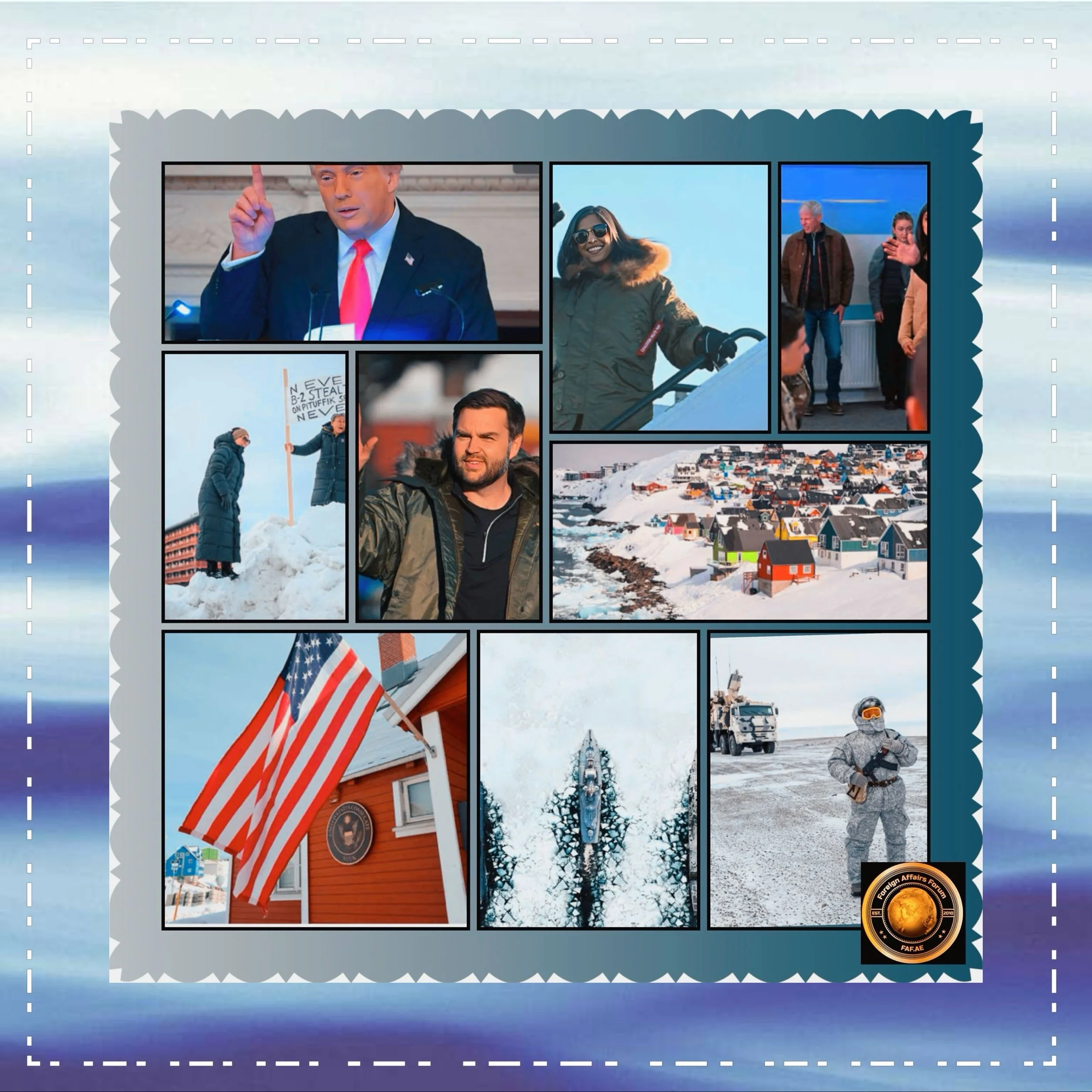Trump Administration’s Greenland Visits Ignite Diplomatic Crisis Amid Sovereignty Dispute
Introduction
The Trump administration’s deployment of high-ranking officials to Greenland has precipitated a significant diplomatic confrontation with Denmark and the European Union, exposing deep tensions over Arctic sovereignty, resource competition, and historical colonial legacies.
Greenlandic Prime Minister Múte B. Egede has denounced the visits as “highly aggressive” and a “demonstration of power,” while President Donald Trump insists the delegation represents “friendliness, not provocation.”
FAF analyzes the geopolitical stakes, Greenland’s domestic political landscape, and the broader implications for transatlantic relations.
The Contested US Delegation
Cultural Engagement or Coercive Diplomacy?
Composition and Stated Objectives
The delegation, scheduled for March 25–28, 2025, includes Second Lady Usha Vance, National Security Advisor Mike Waltz, and Energy Secretary Chris Wright.
Officially, Vance’s itinerary emphasizes cultural engagement: attending the Avanna Qimersu dogsled race, visiting historical sites, and meeting local artisans. However, Waltz’s parallel agenda—a tour of the Pituffik Space Base, a critical node in the U.S. Space Force’s Arctic surveillance network—has drawn scrutiny.
Though less publicized, Energy Secretary Wright’s participation aligns with Greenland’s reserves of rare earth minerals vital for renewable energy technologies.
Trump framed the visits as reciprocating Greenlandic “requests,” asserting, “They’re calling us; we’re not calling them.”
White House Press Secretary Karoline Hughes said the trip would “enhance partnerships respecting Greenland’s self-determination.” Yet Greenlandic officials dispute this narrative, with Egede stating, “Our government extended no formal invitation.”
Greenland’s Leadership Rejects US Narrative
Prime Minister Egede dismissed the delegation’s cultural pretext, arguing Waltz’s involvement revealed ulterior motives: “What is the national security adviser doing here?
The sole aim is to assert dominance”. He characterized the visit as part of a sustained U.S. pressure campaign, noting, “The intensity of American demands has reached intolerable levels.”
Egede’s caretaker government refused meetings with the delegation, a stance supported by Jens-Frederik Nielsen, leader of the Democratic Party and likely next prime minister, who called the timing “disrespectful” amid ongoing coalition negotiations.
Greenland’s Political Crossroads
Sovereignty vs. External Pressures
Post-Election Fragility
The March 11 parliamentary elections reshaped Greenland’s political landscape.
The pro-independence Democrats (Demokraatit) secured 10 of 31 seats, followed by the Naleraq Party (8 seats), which advocates immediate sovereignty, and Egede’s Inuit Ataqatigiit (IA) party (7 seats), which favors gradual independence.
While the Democrats and Naleraq oppose U.S. annexation, their differing timelines have complicated coalition talks. Nielsen criticized the U.S. for exploiting this instability: “Arriving during municipal elections and government formation shows contempt for our democracy.”
Public Sentiment and Colonial Legacies
Recent polls indicate that 85% of Greenlanders reject U.S. annexation, a sentiment rooted in centuries of Danish colonial rule.
Egede framed Trump’s overtures as a continuation of external domination: “This assault on our sovereignty mirrors historical subjugation—first by Denmark, now by America.”
The island’s 1979 self-rule agreement granted control over domestic affairs, yet Denmark retains authority over foreign policy and defense, a duality that complicates Greenland’s geopolitical positioning.
Denmark and the EU Respond
Sovereignty and Security
Military and Diplomatic Mobilization
Denmark dispatched additional police units and bomb-sniffing dogs to Greenland, ostensibly for “routine security” but widely interpreted as a deterrent against U.S. provocations.
Foreign Minister Lars Løkke Rasmussen reaffirmed Greenland’s status as “an inseparable part of the Kingdom,” while EU Commission President Ursula von der Leyen declared, “European solidarity with Denmark is absolute.”
However, the EU’s refusal to send its delegation drew criticism from Egede, who argued, “Silence from allies emboldens American aggression.”
NATO’s Dilemma
The crisis strains NATO cohesion. Denmark, a founding member, hosts the U.S. Pituffik base under a 1951 defense agreement.
Trump’s suggestion to leverage NATO support for annexation—reportedly floated to Secretary-General Mark Rutte—places the alliance in a bind, balancing collective defense commitments against member-state sovereignty.
Trump’s Annexation Doctrine
Strategic Calculus and Historical Precedents
Articulating Expansionist Ambitions
Trump’s public remarks have escalated from speculative interest to explicit territorial claims. During a March 24 cabinet meeting, he declared, “Greenland cannot persist in its current state.
It will be part of our future”. Earlier, he told Congress, “We will secure it one way or another,” echoing 19th-century manifest destiny rhetoric. Advisors attribute this push to Greenland’s strategic assets:
Arctic Trade Routes
Melting ice caps could unlock the Northwest Passage, reducing shipping times between Europe and Asia by 40%.
Military Positioning
Pituffik’s radar systems provide early warning for intercontinental ballistic missiles, a capability Trump seeks to expand.
Resource Wealth
The island holds 38.5 million metric tons of rare earth oxides, which are critical for semiconductors, EVs, and defense systems. China currently controls 90% of the island.
Historical Parallels and Legal Challenges
U.S. interest in Greenland dates back to 1867 when Secretary of State William H. Seward proposed purchasing it after acquiring Alaska. President Harry S. Truman revived the idea in 1946, offering Denmark $100 million in gold.
International law, however, prohibits territorial acquisition by coercion under the UN Charter’s Article 2(4).
Legal scholars note Trump’s approach risks violating this principle, as Denmark’s 1953 accession to NATO included Greenland under its defense umbrella without ceding sovereignty.
Geopolitical Repercussions
Arctic Rivalries and Global Alliances
Sino-Russian Reactions
China’s Foreign Ministry condemned the “neo-colonial gambit,” while Russia’s Arctic Ambassador Nikolay Korchunov warned of “reciprocal measures” to protect regional interests.
Both nations have accelerated infrastructure investments in northern Greenland, with Chinese firms securing mining rights to the Kvanefjeld rare earth deposit.
Transatlantic Relations at Risk
The EU’s vocal support for Denmark contrasts with muted responses from other NATO allies.
German Chancellor Lisa Paus cautioned against “unilateralism that fractures Western unity,” while French President Emmanuel Macron proposed EU-led Arctic patrols to counter U.S. and Russian militarization.
Conclusion
Sovereignty Under Siege in the New Arctic Order
The U.S. delegation’s visit underscores the Arctic’s emergence as a 21st-century Great Game arena.
Greenland’s leadership faces dual challenges: navigating great-power competition while advancing decolonization from Denmark.
Trump’s amalgamation of cultural outreach and brutal power tactics—exemplified by juxtaposing Vance’s dogsled diplomacy with Waltz’s military tour—reveals a strategy of coercive persuasion.
The crisis tests the EU and Denmark's capacity to uphold sovereignty norms against a U.S. administration increasingly dismissive of multilateral frameworks.
As climate change renders the Arctic more accessible, Greenland’s fate may signal whether resource nationalism or cooperative governance will define the region’s future.
Egede’s plea—“We need voices, not silence”—highlights the precarious position of small states in an era of resurgent expansionism.
As Nielsen’s government takes shape, the coming weeks will determine whether Greenland can leverage its strategic value into diplomatic autonomy or succumb to what local activists term “the second colonization.”






